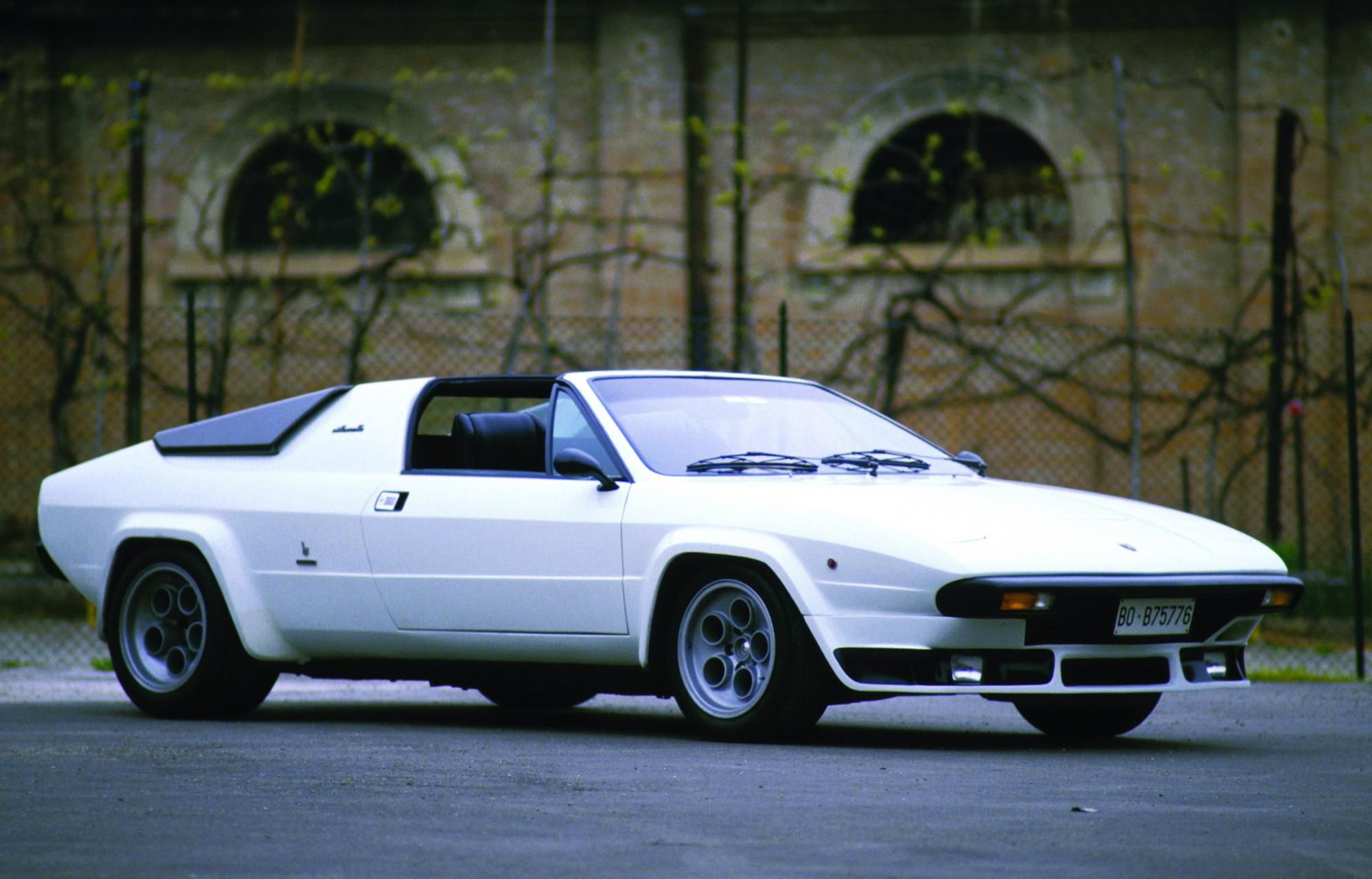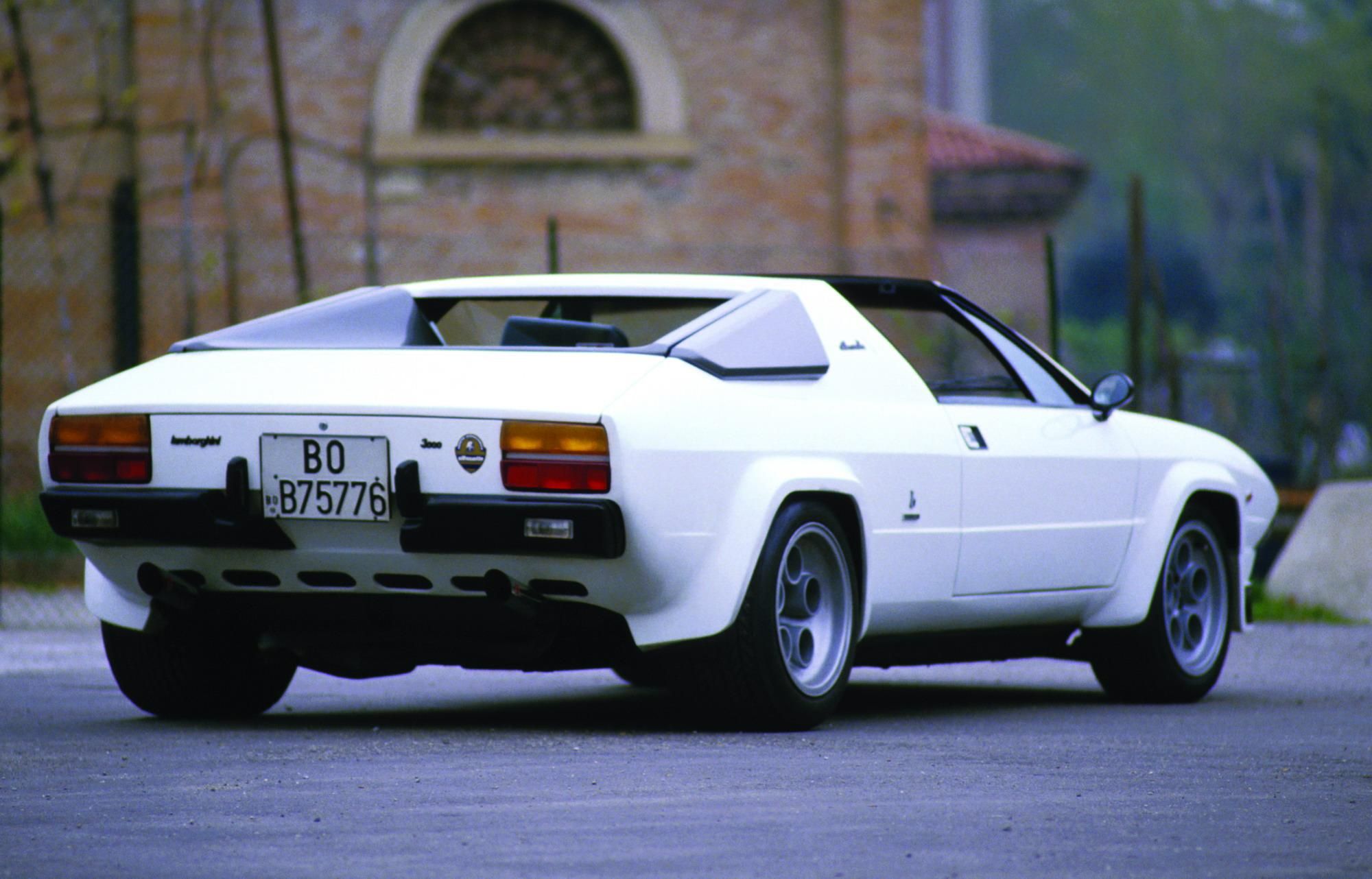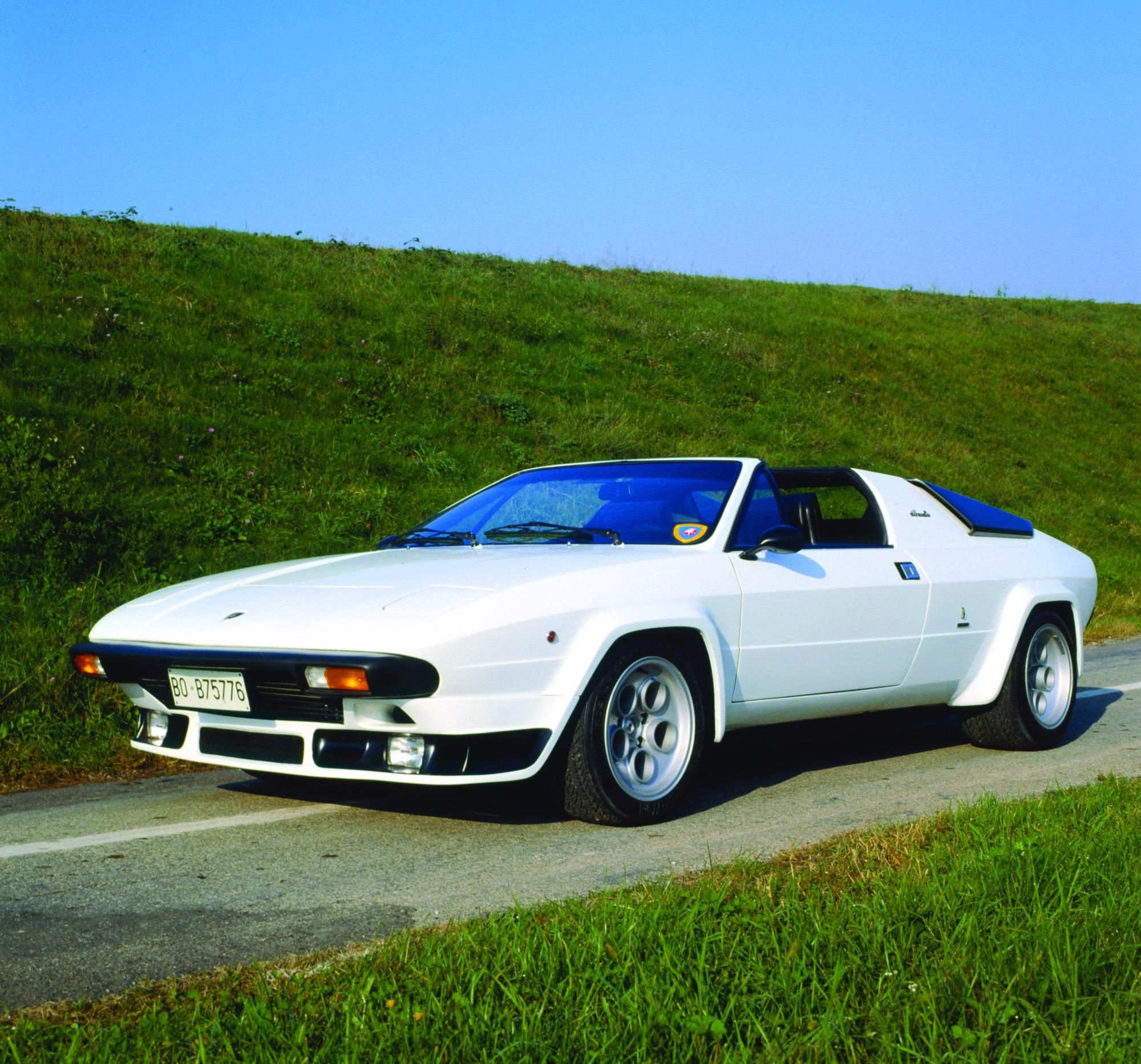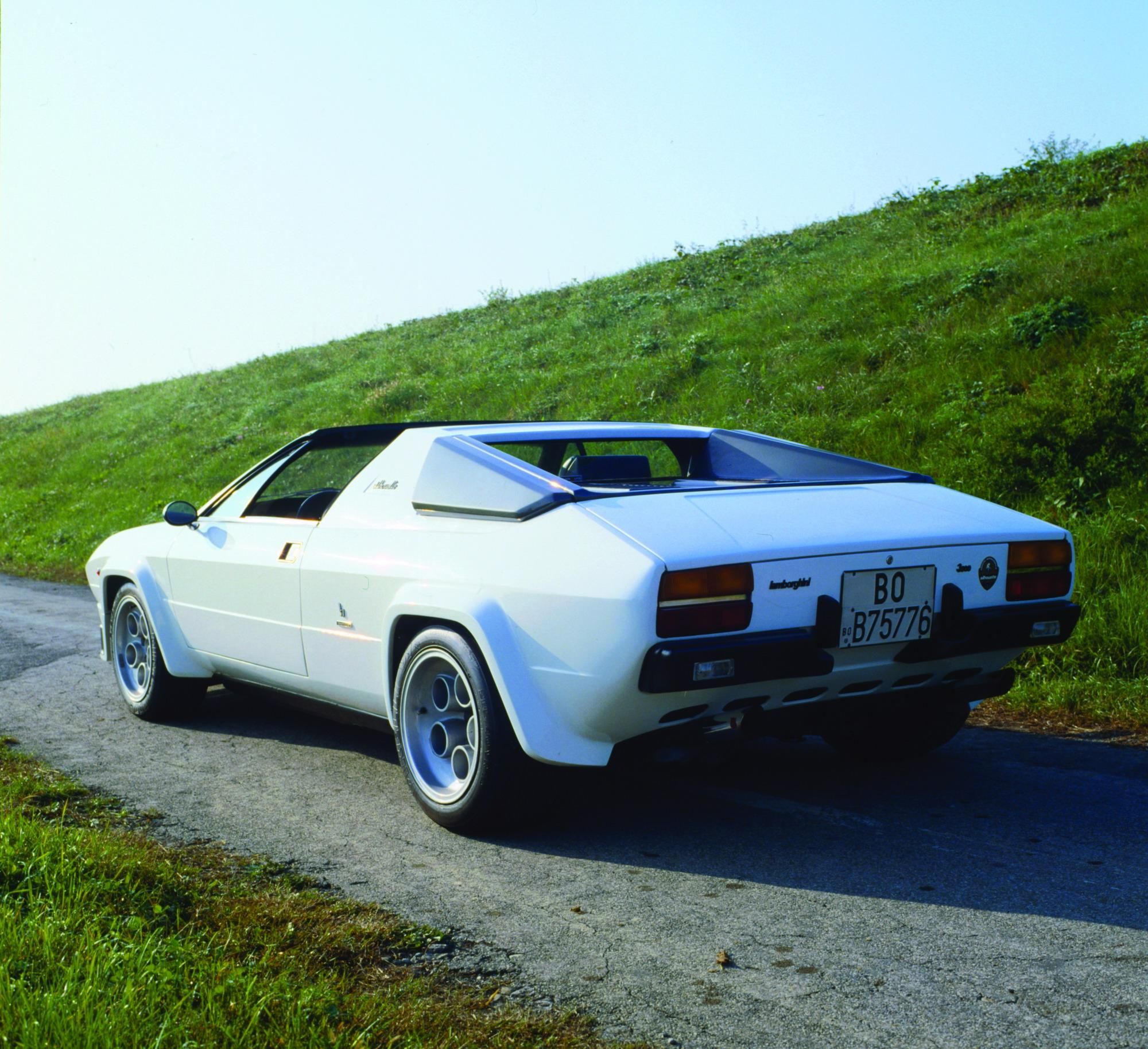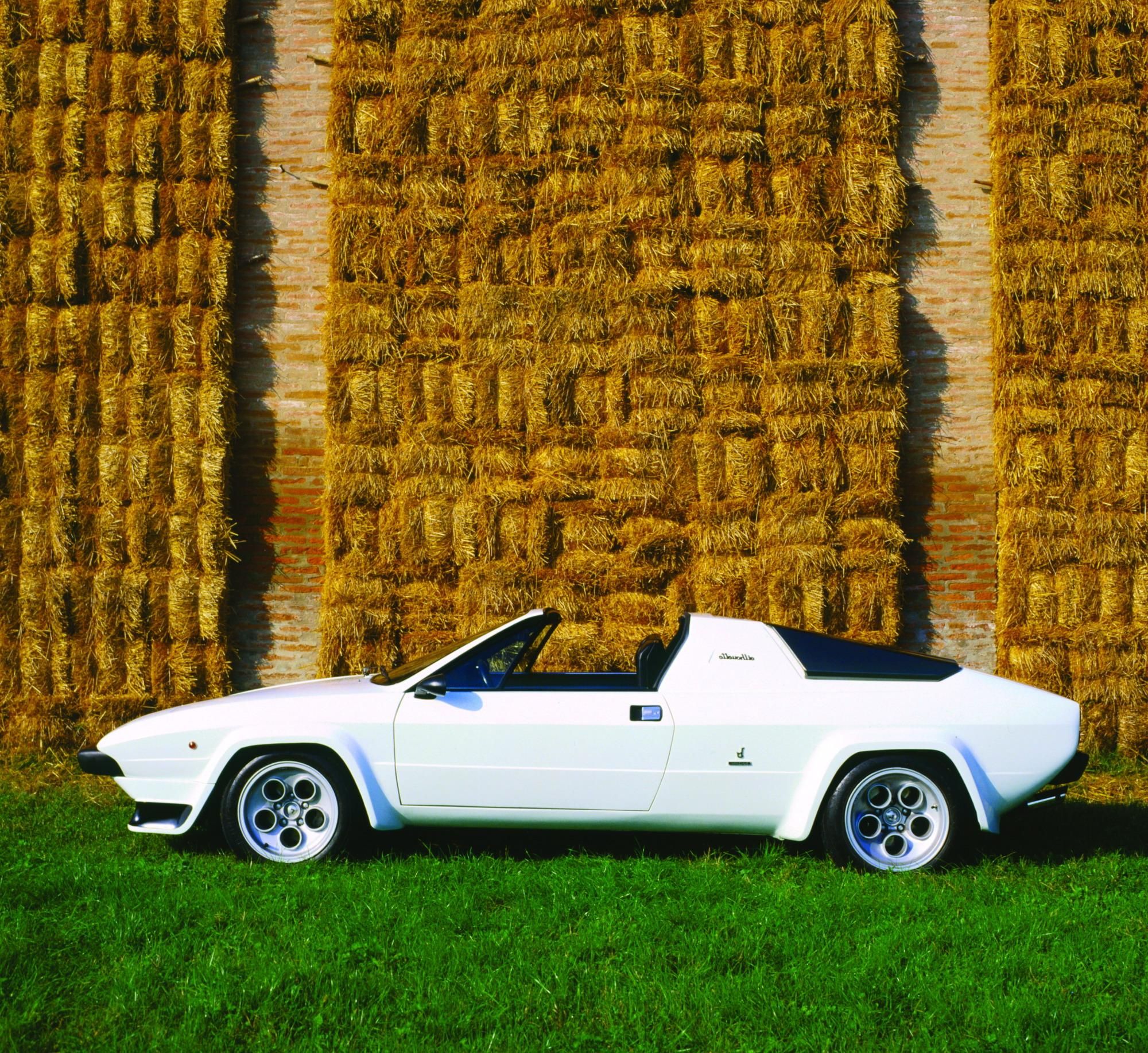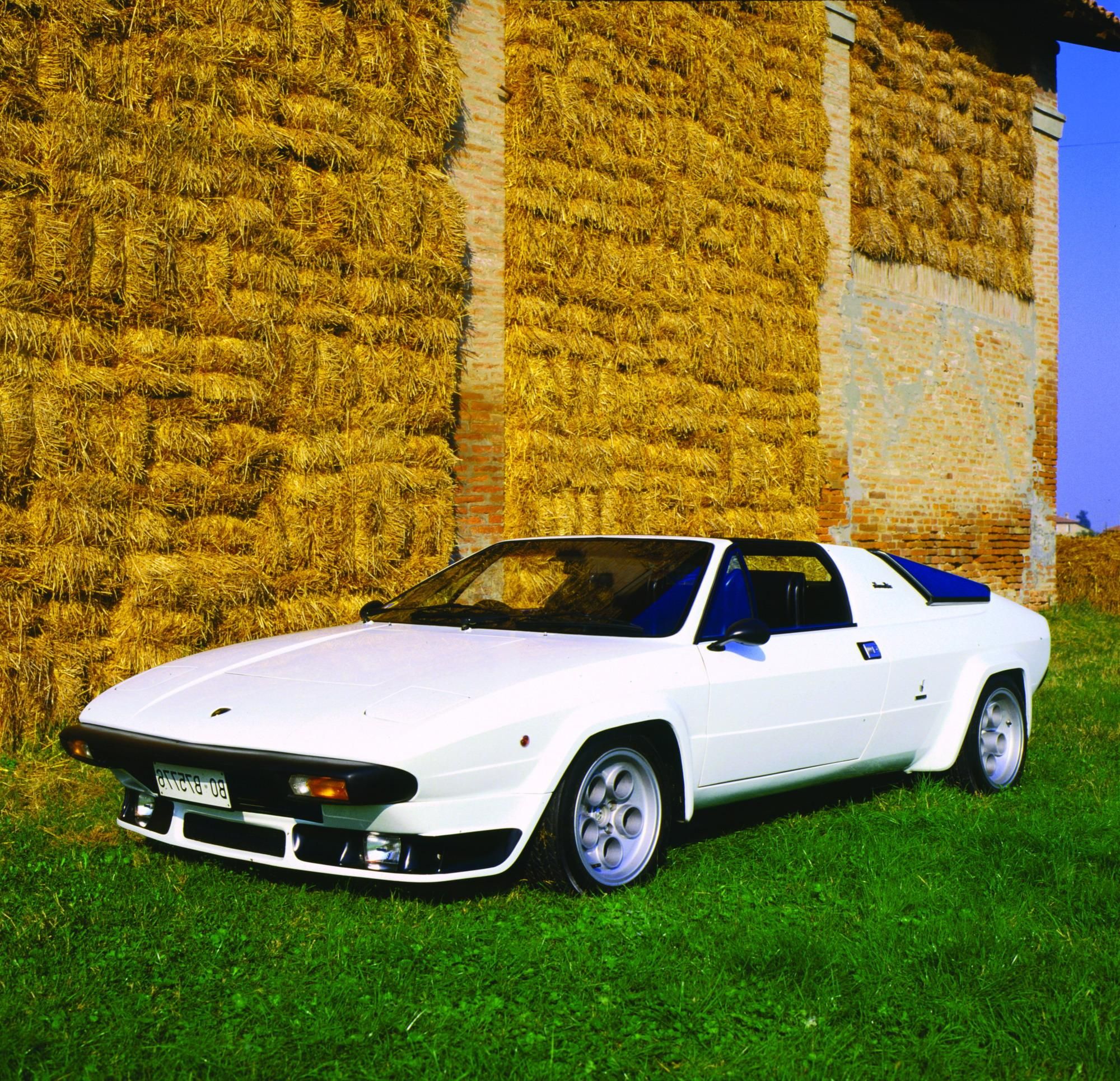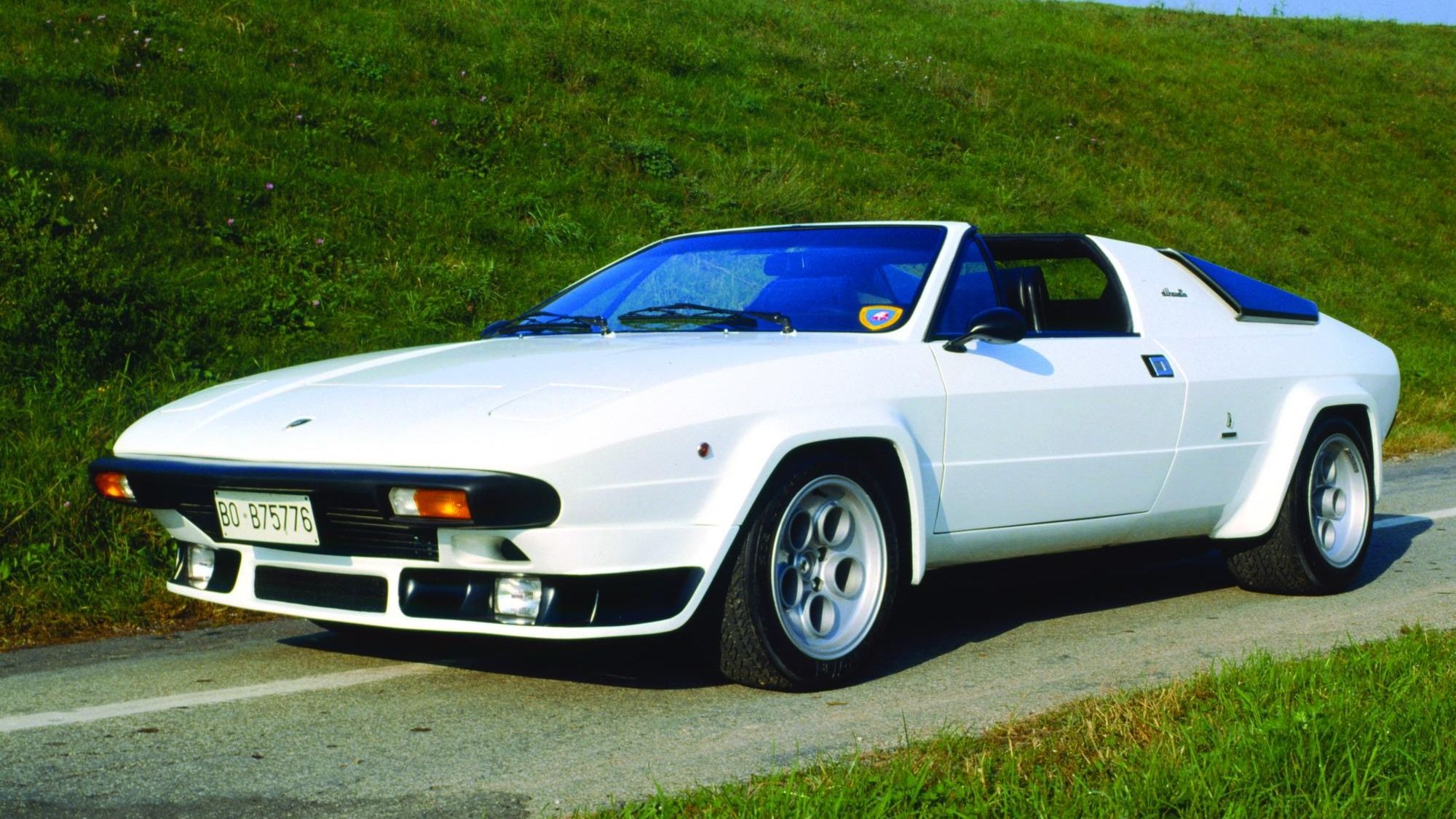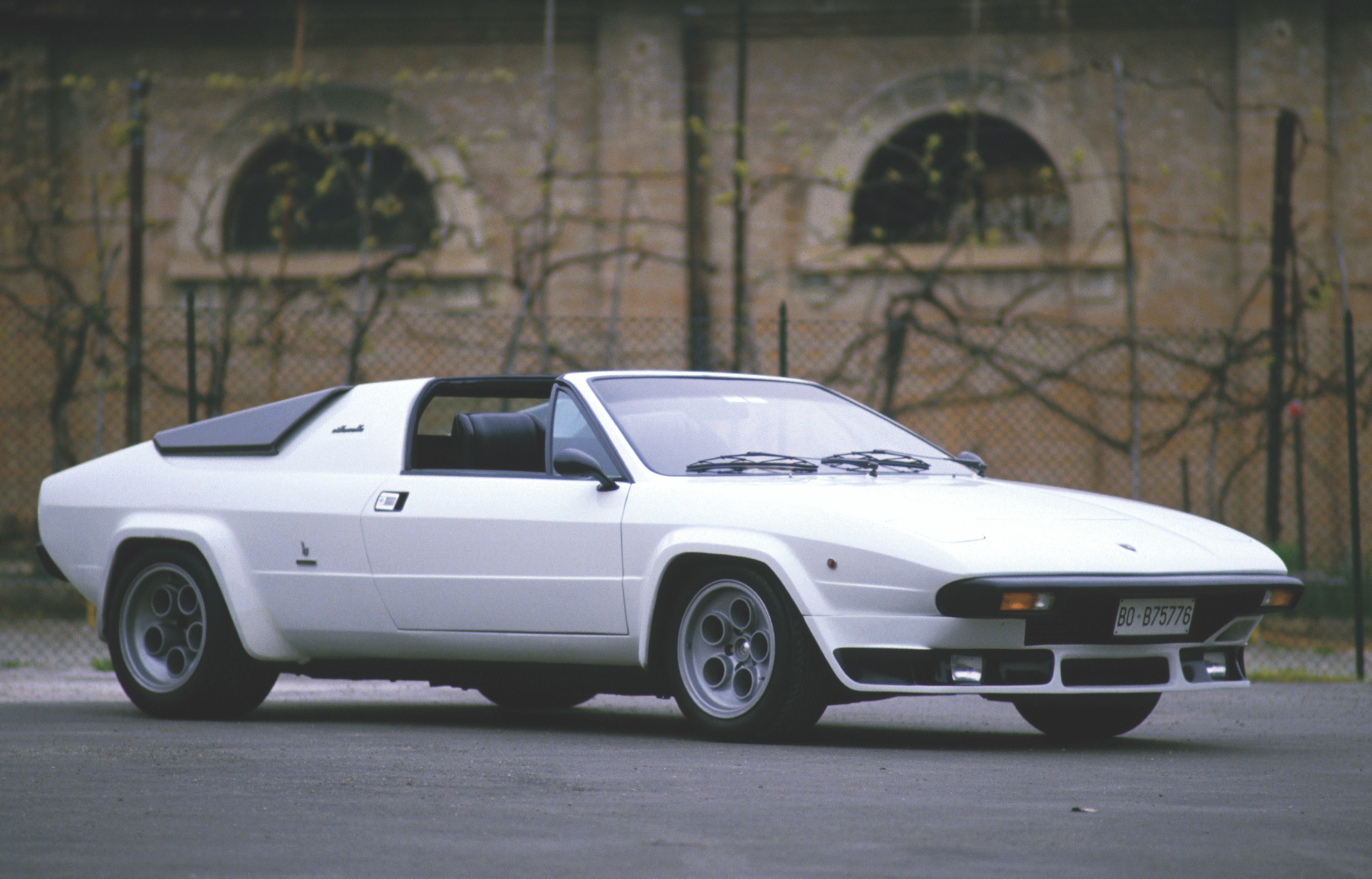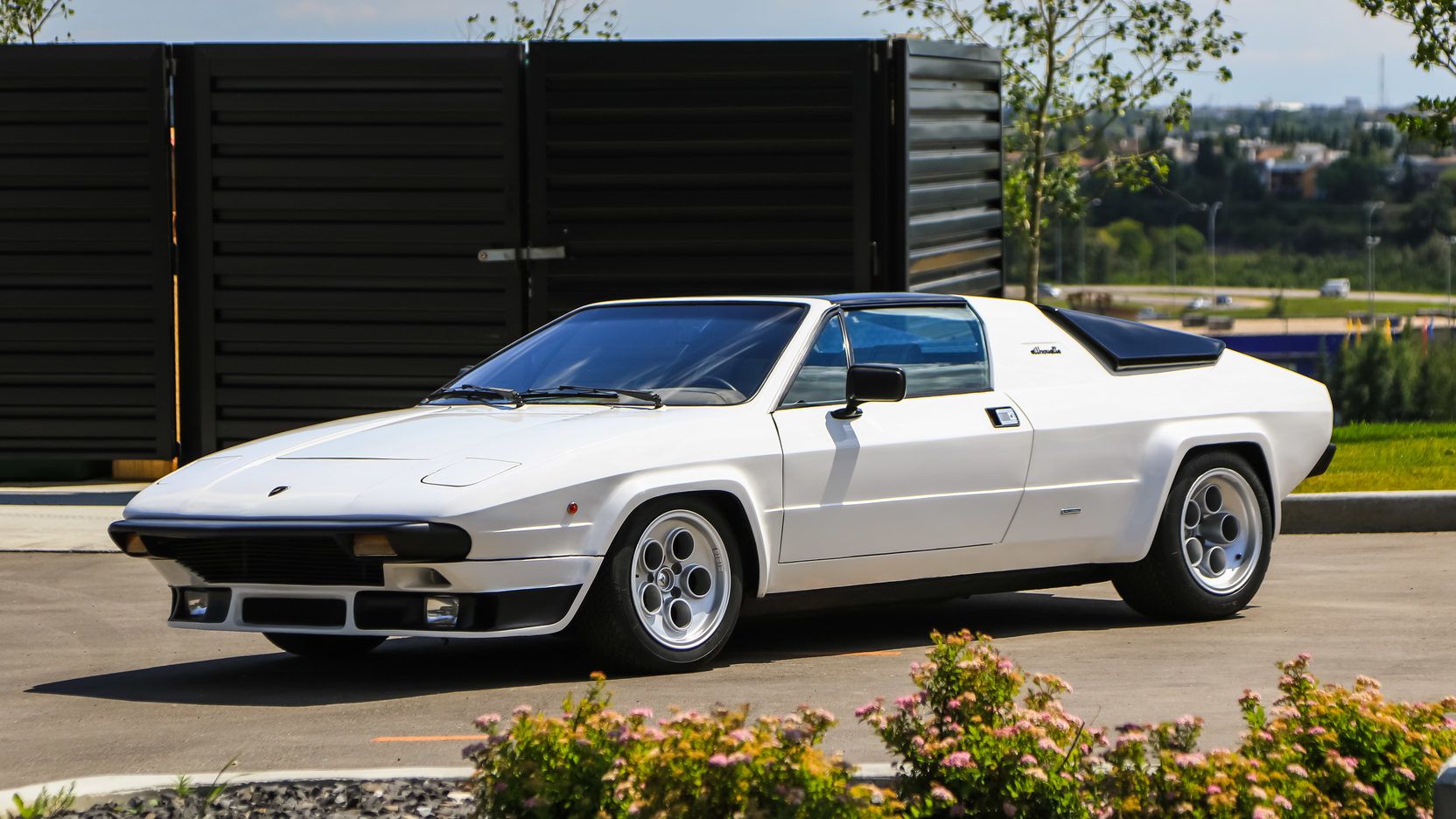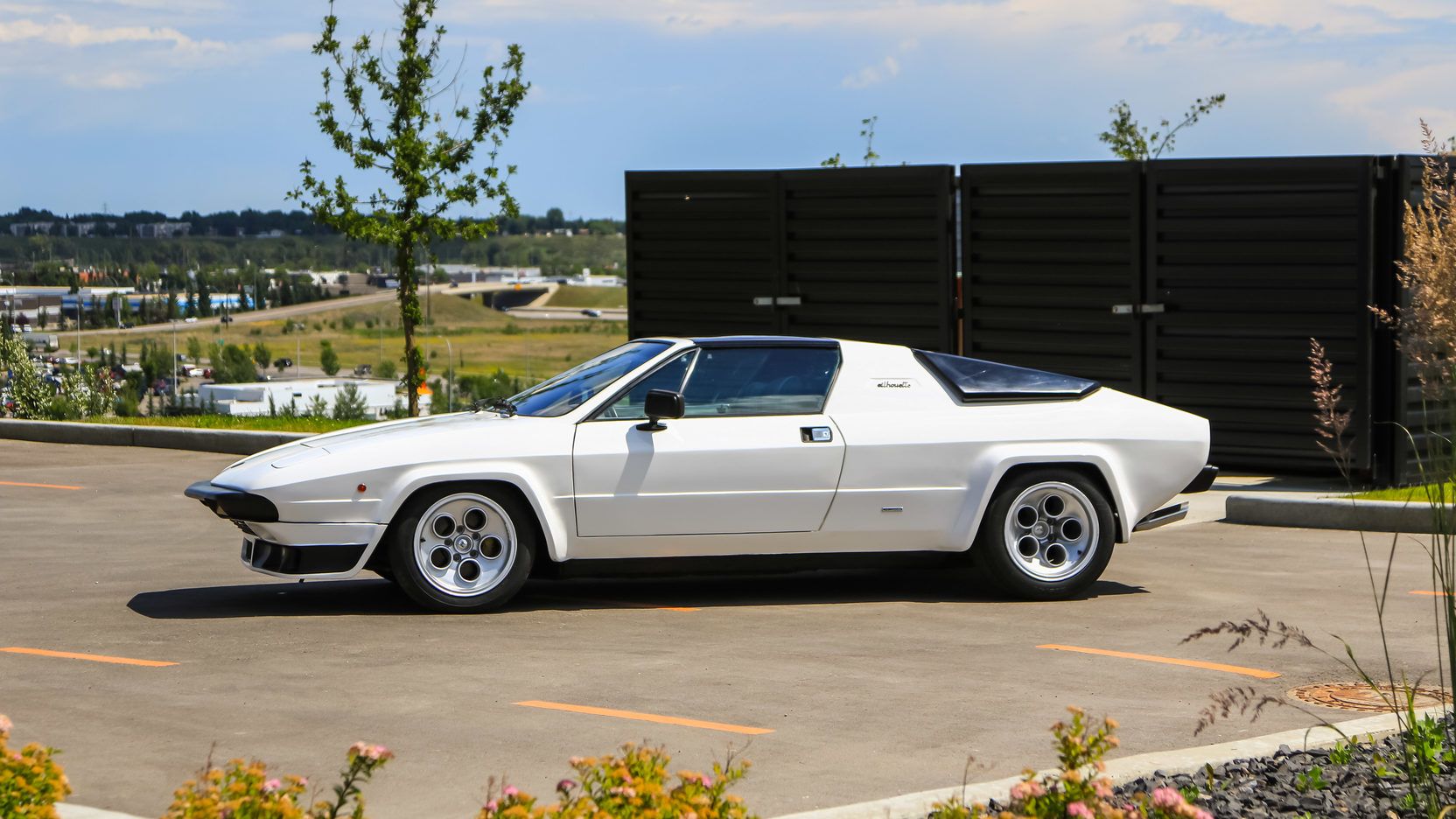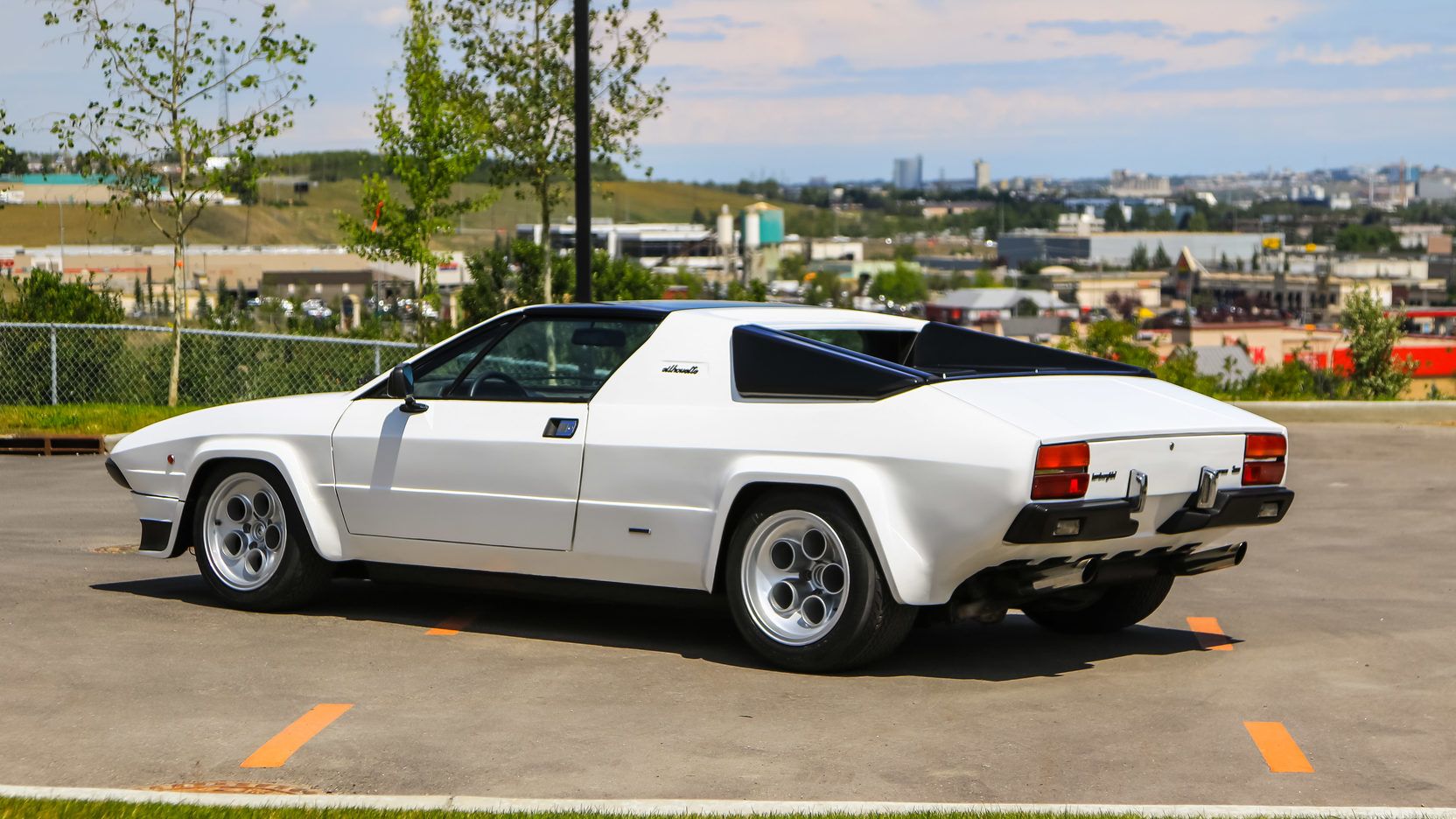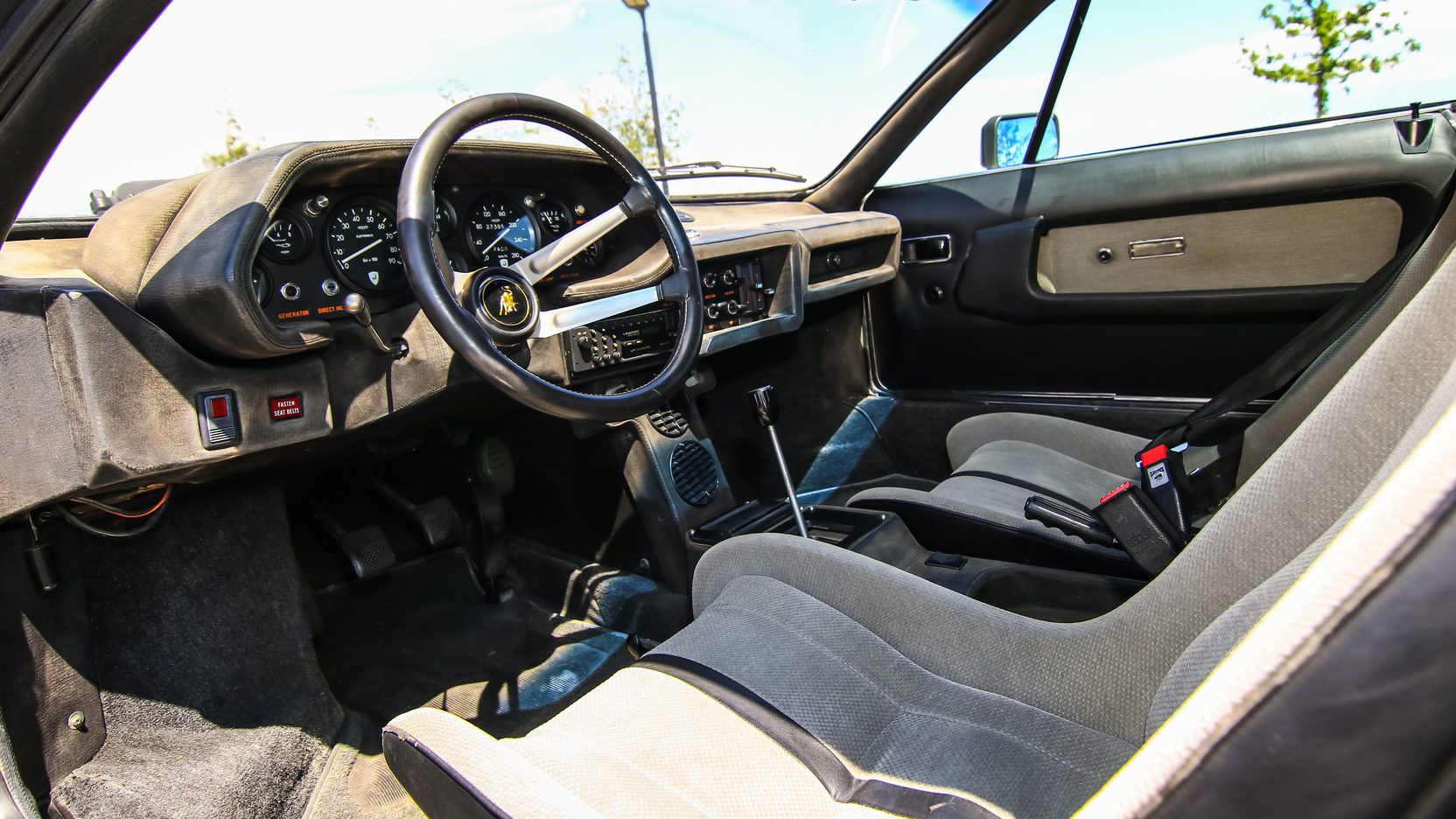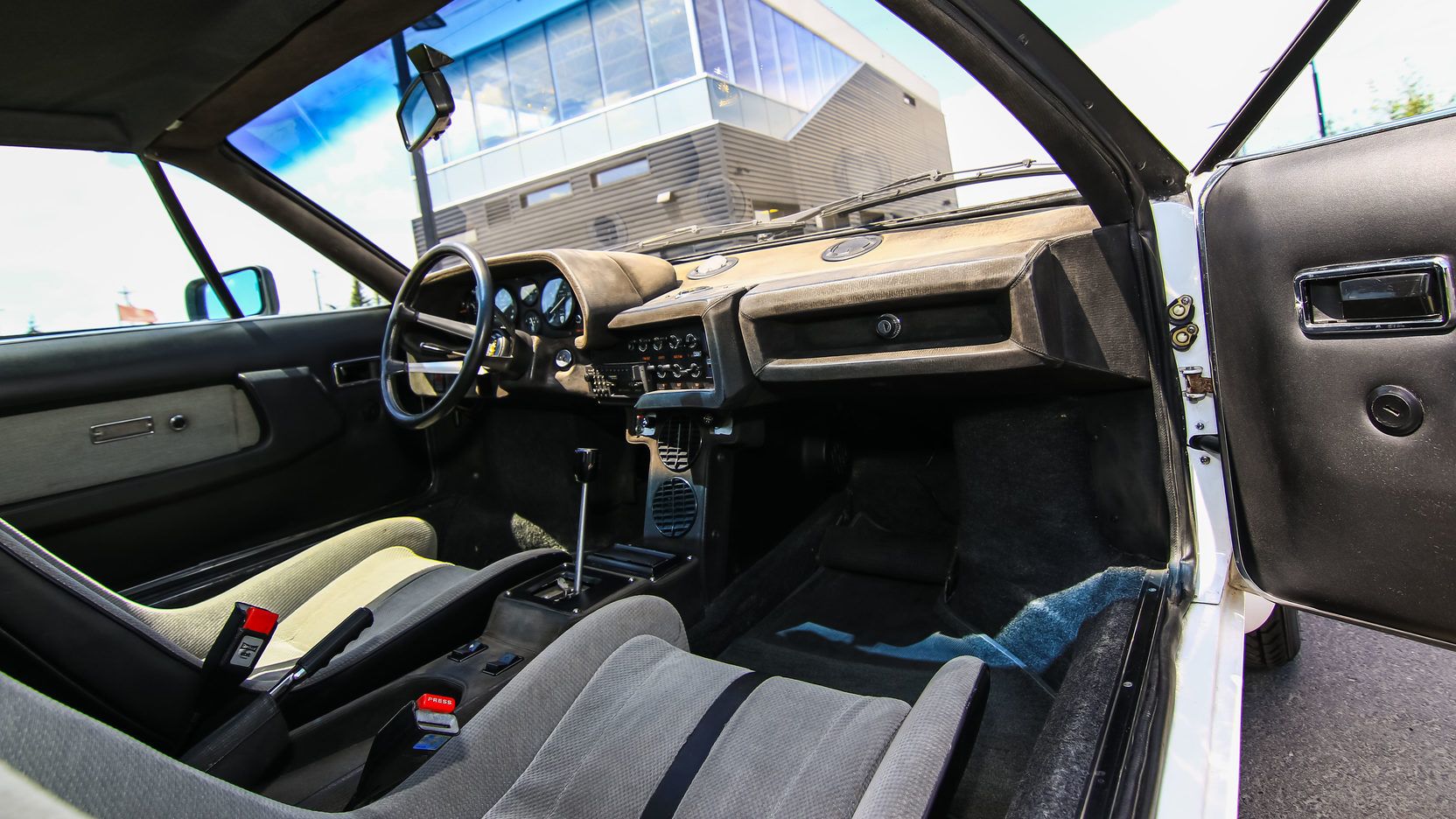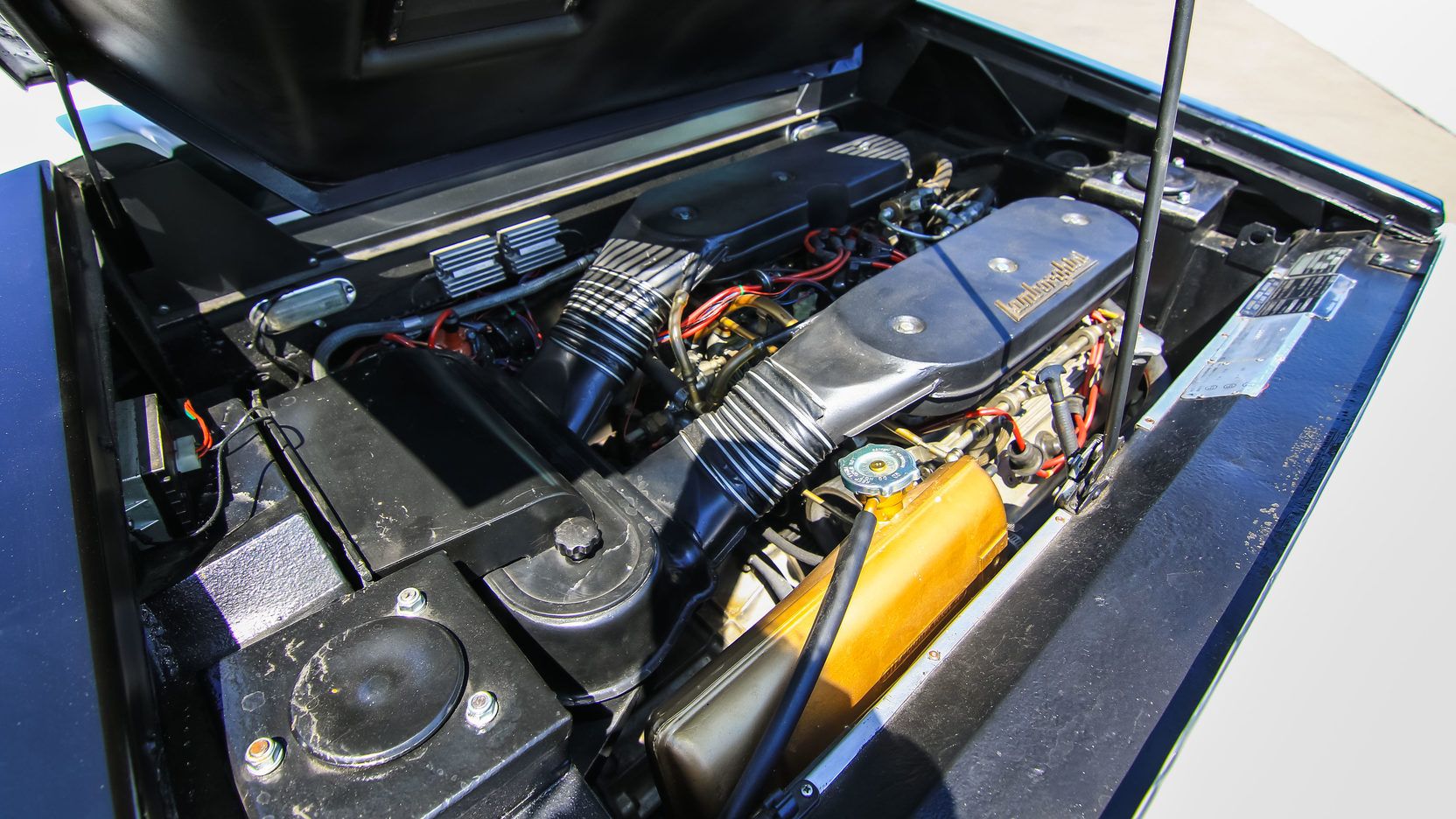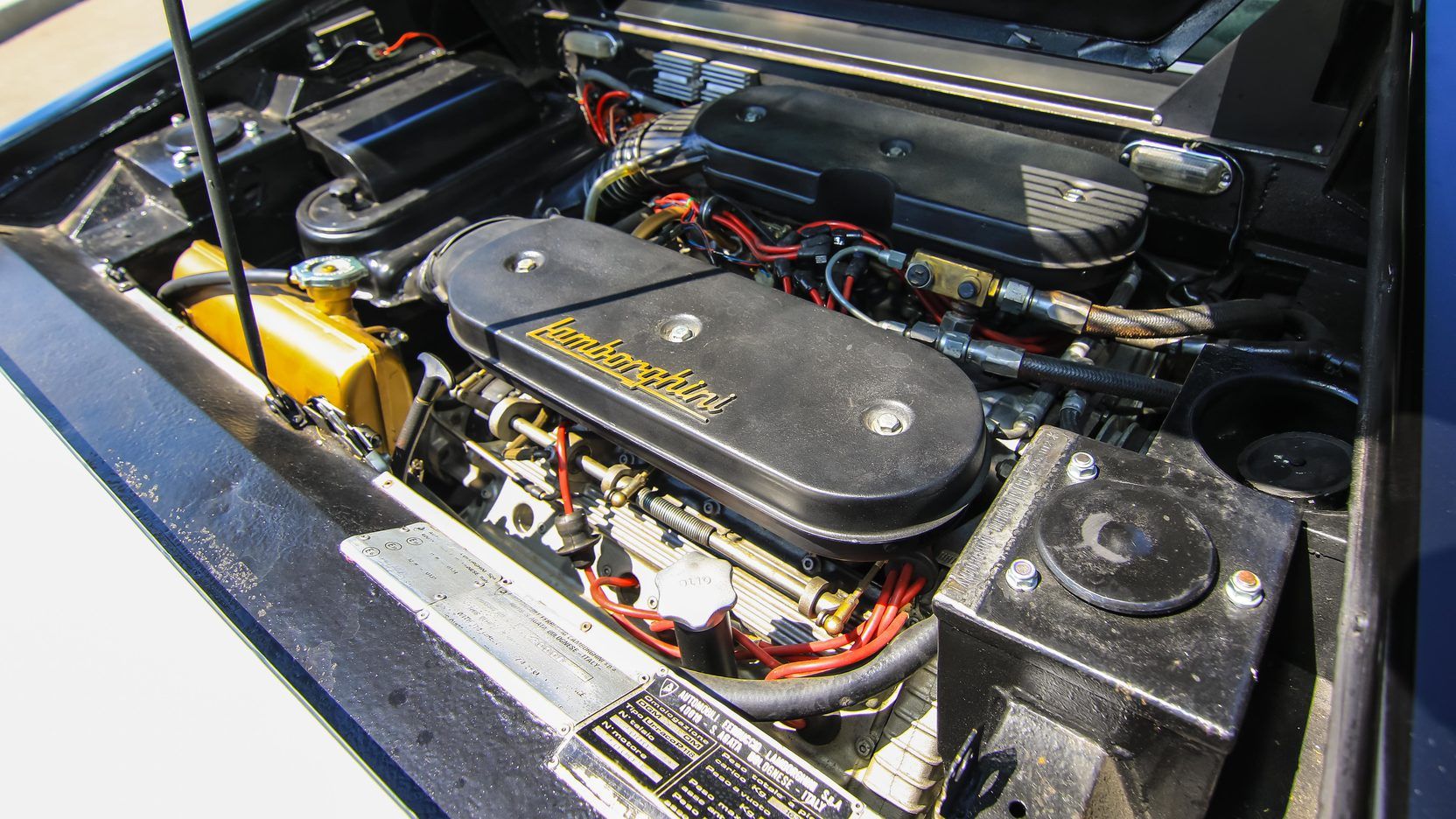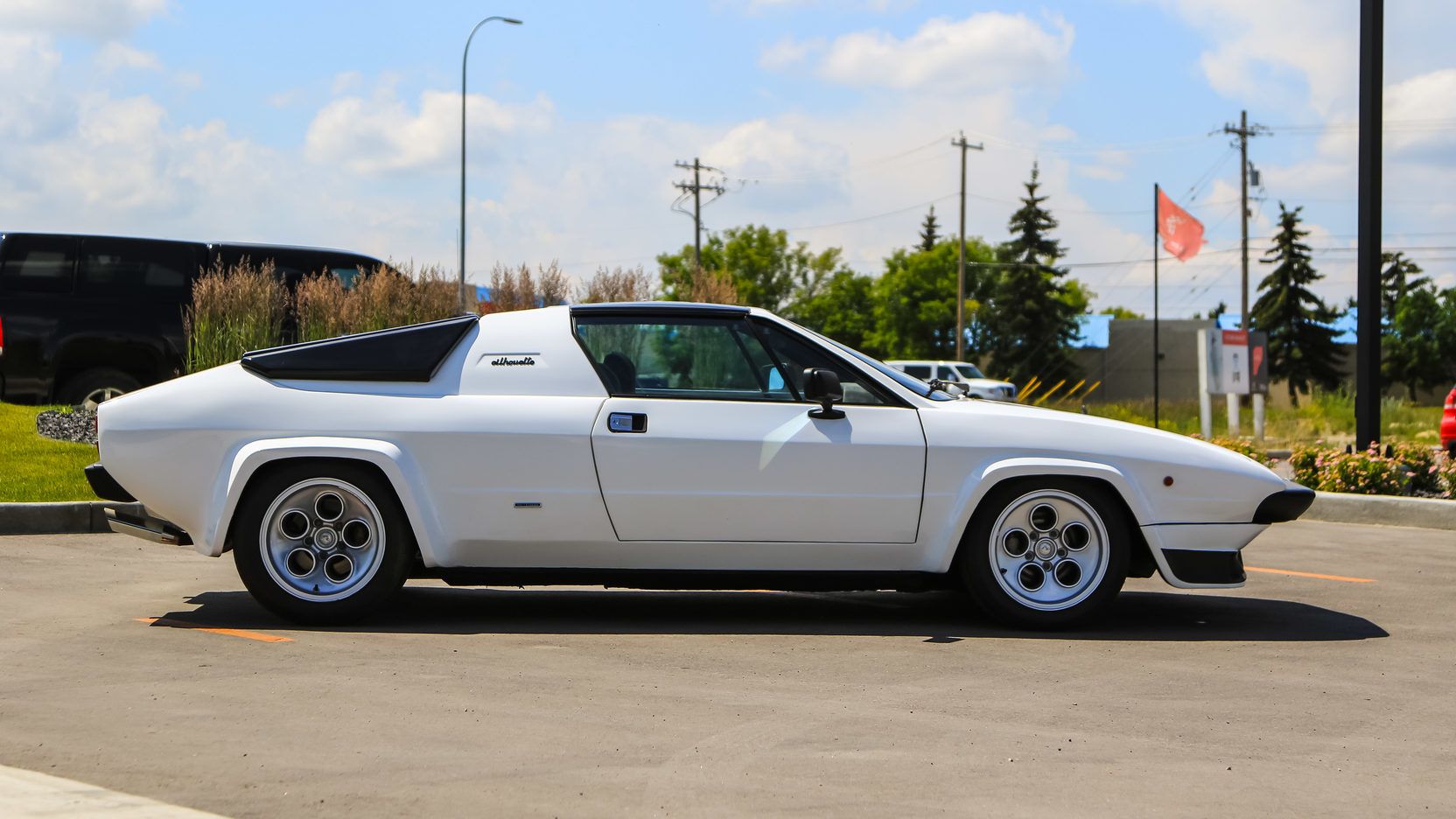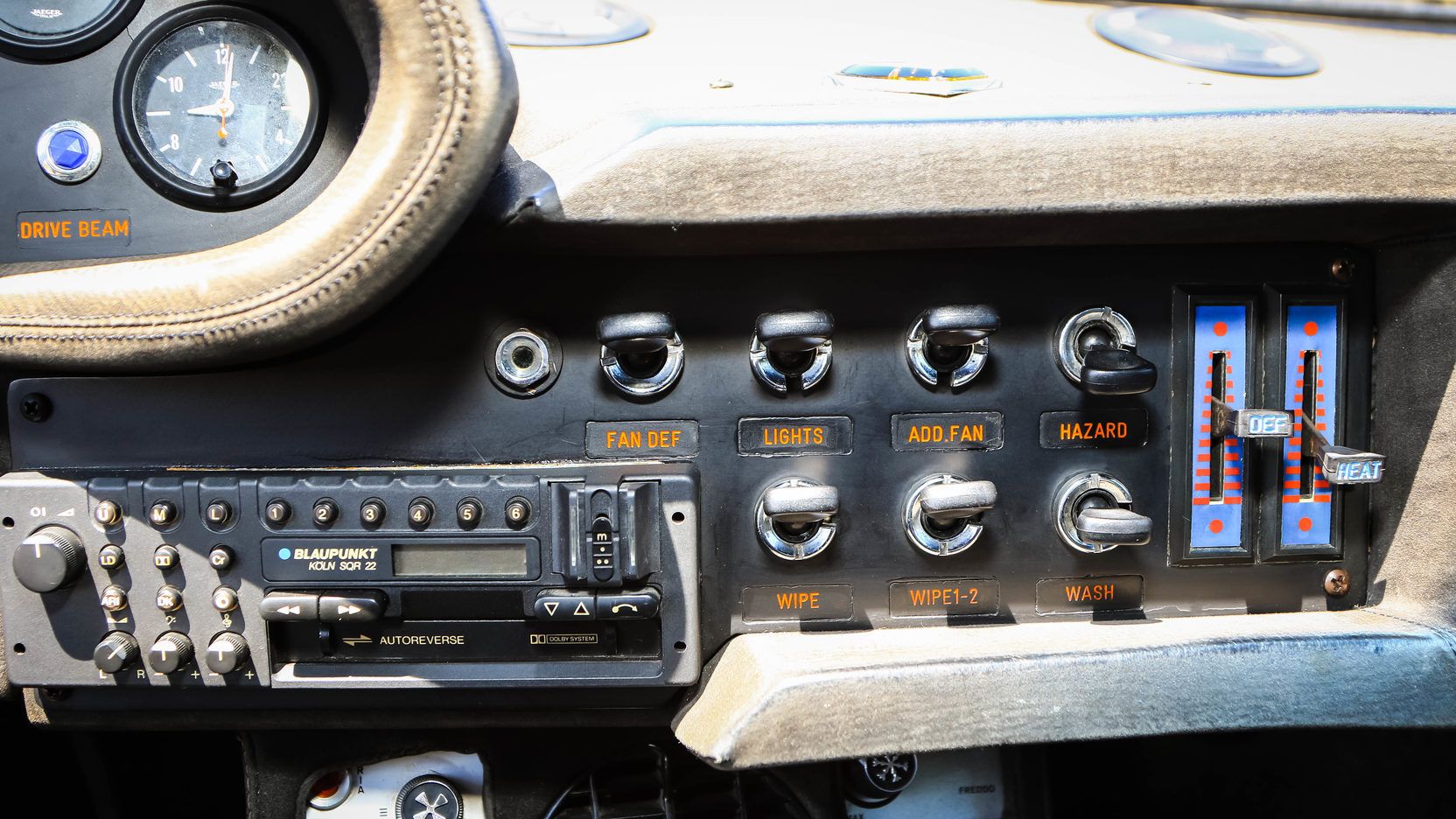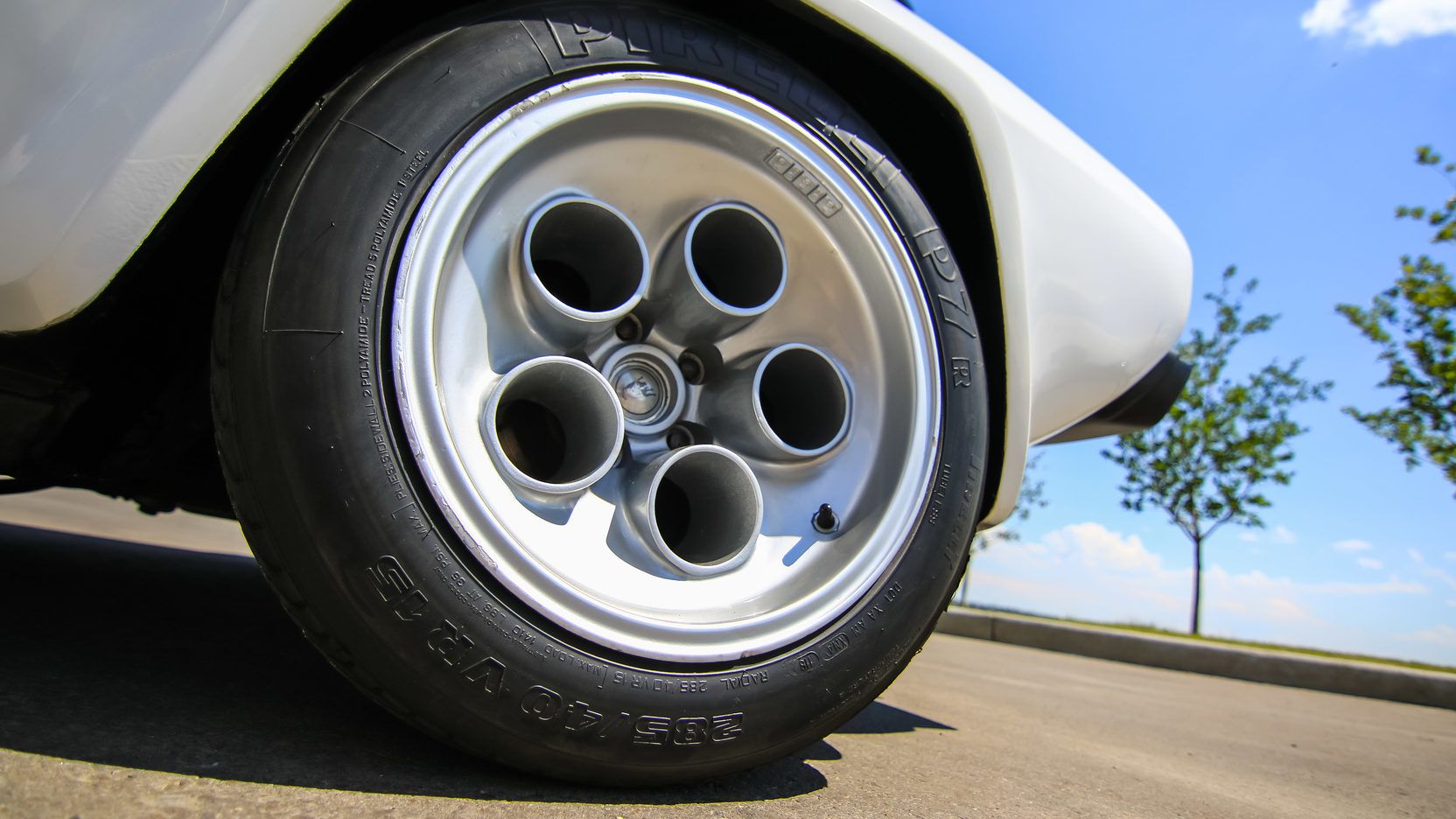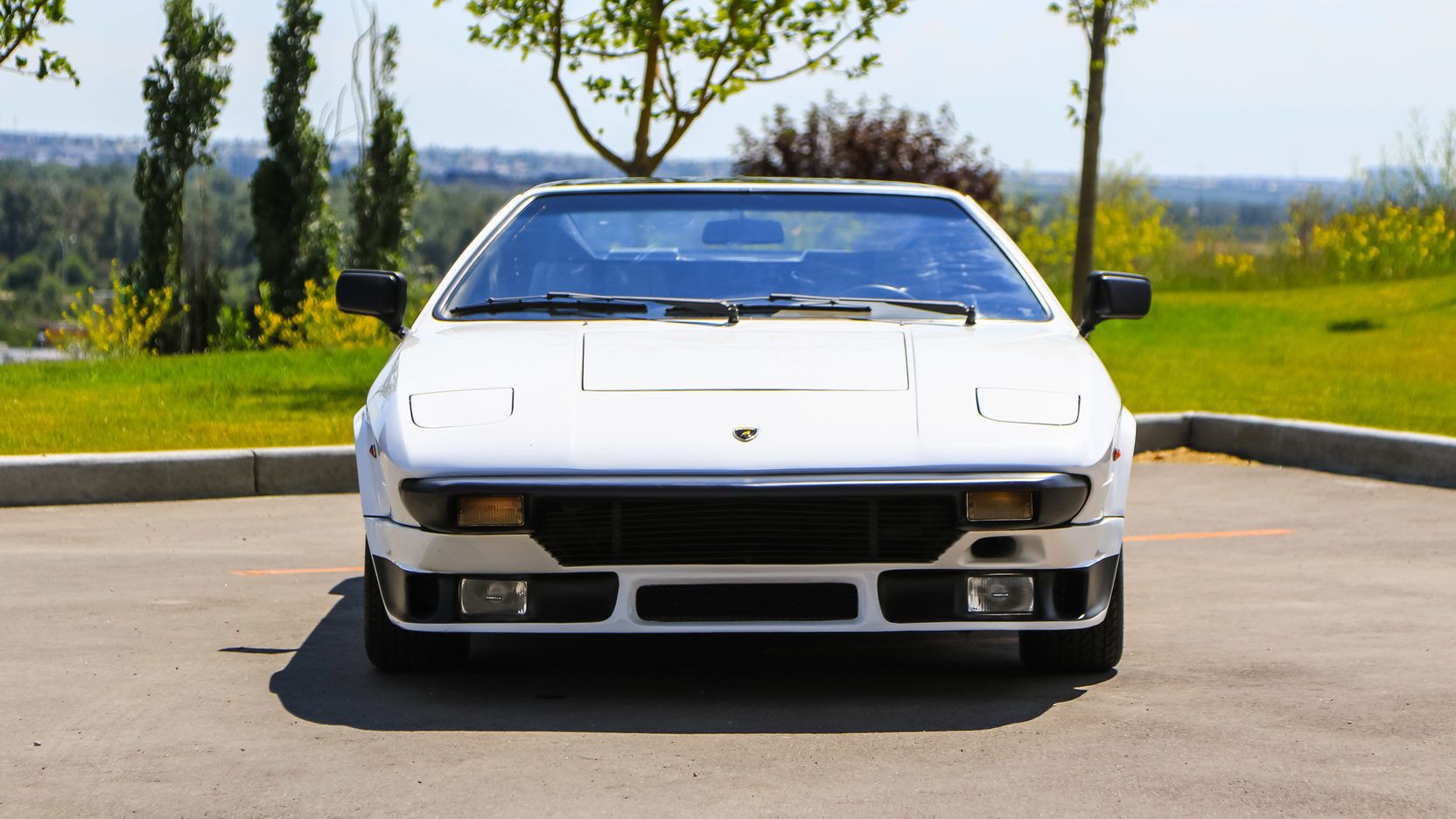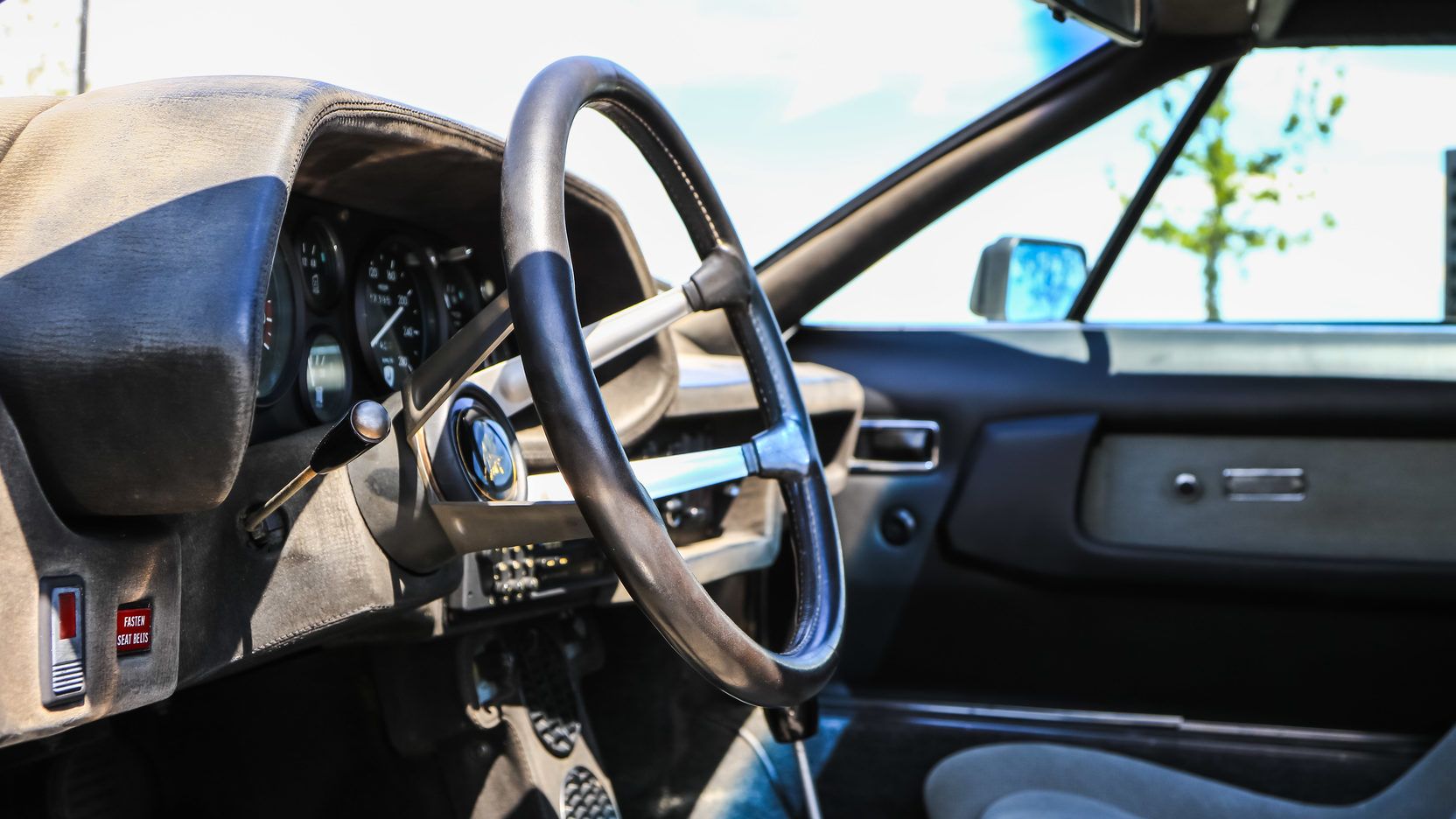Lamborghini launched the Silhouette in 1976 as an attempt to appease customers that didn't buy the Urraco, the company's first V-8 model, with a car that featured the same underpinnings but a more modern styling in tune with the Countach. Sadly for Lamborghini, it didn't work out, but Lamborghini still had the Jalpa up its sleeve.
The Silhouette was a more angular-looking sports car, in tone with the Countach. It had square, flared wheel arches, an aggressive nose, and a sleek rear section with two black air vents covering the area aft of the B-pillar. The wheels were also new and they would go on to become a sort of a staple on Lamborghini models. The Silhouette was also one of the few to not be named after a fighting bull or a breed of bulls and the first from Sant'Agata Bolognese to feature a removable targa top.
The Silhouette, in keeping with the budget sportscar ethos pushed forward by Ferruccio when conceiving the Urraco, was never meant to be an out-and-out performer. As such, with a 3.0-liter V-8 behind the seats, the power output was advertised at a docile 266 horsepower - 40 less than a modern-day Seat Leon Cupra R hot hatch- with a resulting top speed of 162 mph or 12 mph less than a de-restricted Audi RS3 hot hatch that you can buy in 2018.
1976 - 1979 Lamborghini Silhouette
- Make: Array
- Model: 1976 - 1979 Lamborghini Silhouette
- [do not use] Vehicle Model: Array
1976 Lamborghini Silhouette Exterior
By the mid-'70s, the Urraco that should've brought significant revenue in Lamborghini's pockets was barely selling. It had been plagued by the poor fit and finish of the early P250 examples and, before Lamborghini could get to work, refine it and bring the P300 to the market, the market already had made up its mind: the first V-8-engined Lamborghini wasn't a chart-topper.
Even the Marcello Gandini-designed body with its sleek roofline that accommodated four seats inside the cabin wasn't considered amazing. At least not when the same Gandini created the Countach merely two years after the Urraco went into production. So, the Urraco needed a styling upgrade but, due to the high expense put into creating that model in the first place, Lamborghini couldn't just halt its production to make room for a replacement.
One could say that the Silhouette wasn't the successor of the Urraco as such but more like a redesigned open-top version of the Gandini-styled car that was also designed by the design house that had Gandini on their payroll, Bertone. The Italian company quickly rose to the task and essentially eliminated the roof of the Urraco and changed little else, maintaining the 2+2 layout. Another visual differentiator was the chromed B-pillar which included a roll hoop that was needed since a convertible has less structural rigidity due to the deletion of the fixed roof.
Lamborghini reckoned the changes were too subtle and demanded more. Soon enough, the 5-hole phone dial-esque wheels arrived and the rear seats were disposed of to have a place to fit the removable targa roof. The new wheels demanded wider arches so the prototype received some round wheel arch extensions. More modifications were made around the rear as the back side windows disappeared and were completely replaced by the side air vents. The louvered engine lid was also gone and a more traditional flat lid was put in place, which allowed for slightly better visibility although the rear window was still offering a tight view behind since it sat between the car's lowering roof buttresses.
Finally, after more tweaks and road tests, the Silhouette was unveiled in its final form at the 1976 edition of the Geneva Auto Show.
Up front, the Silhouette features a much more aggressive splitter that dips lower than on any Urraco. The lower part of the bumper features a multitude of recessed areas and air vents. You've got two vertical vents placed in each of the two corners of the bumper with two more placed above the fog lights, on either side of the main inlet. The fog lights themselves sit in a recessed position while an extra, larger duct fits in the protruding area in the middle of the bumper. Above this maze of air vents and pointy creases, there's the plastic front bumper which widens to the sides to host the indicators and is incorporated into the car's nose.
The pop-up headlights of the Silhouette are identical to those on the Urraco but what's different is the front hood that's flat on this model, lacking any air vents. The boxy front wheel arches are cleverly integrated into the car's overall design as the protruding line of the fender extensions begins from the lower edge of the front bumper. There's one character line that runs down the sides of the Silhouette, only interrupted by the wheels, but, beyond that, the car has a clean profile. There is, though, at least one Silhouette which features some Countach-inspired cheese graters that conceal a small air vent integrated in the rear fender flares. That particular examples also has air vents on the top of the fenders just before the headlights which also have strakes.
At the back, you'll spot the Urraco taillights, with that bar that separate the indicators from the actual brake lights. They sit in the upper corners of the rear center panel, just where the trunk's lid closes. A black, two-piece bumper with incorporated backup lights takes its place underneath while the two exhaust tips exit just below. Just like on the Urraco, the lower part of the SIlhouette's rear bodywork features six oval holes for cooling purposes.
1976 Lamborghini Silhouette Exterior Dimensions
|
Wheelbase |
96.5 inches |
|
Length |
170.1 inches |
|
Width |
74.0 inches |
|
Height |
44.1 inches |
Interior
The steering wheel was the same as before with its four metal spokes that clawed back to the recessed center. Behind it, there's the gauge cluster with the tachometer on the left and the odometer on the right. There are four more gauges there, all with a black background and white lettering.
Below the wide gauge housing, there's the center console itself that's angled minimally towards the driver. Just below the edges of the gauge housing, there are the controls for the radio with more knobs and switches being placed to the right. The round air vents are placed, one on top of the other, on the nearly-vertical lower part of the center stack with the knobs for the ventilation system placed outboard.
The tall stick shifter is placed just behind the ashtray in a heightened area of the transmission tunnel.
1976 Lamborghini Silhouette Drivetrain
Lamborghini used the chassis of the Urraco for the Silhouette project. As such, the car received the same 3.0-liter DOHC engine, albeit with some tweaks.
The power was sent to the rear wheels through that same 5-speed all-synchromesh Lamborghini-made transmission with a 4.00:1 final drive ratio. It's worth noting that the gearbox and differential were built in the same block with the engine itself.
A big difference was in the suspension department as Lamborghini decided that the rear MacPherson struts - a production first when introduced on the Urraco - aren't going to stick around for the Silhouette. As such, this model has MacPherson struts only on the front axle, with lower A-arms, compliance struts, and coil springs over tube shocks with one anti-roll bar. At the back, the decision was made to utilize Chapman struts, reversed lower A-arms, and trailing arms with the same coil springs and shocks combo.
Stopping power was offered by all-wheel Girling ventilated disc brakes. Steering was by rack and pinion, unassisted.
1976 Lamborghini Silhouette Specifications
|
Engine |
V-8, 90-degree, DOHC, chain-driven, light-alloy and aluminum block, naturally-aspirated 3.0-liter |
|
Output |
266 horsepower at 7,500 rpm |
|
Torque |
201 pound-feet of torque at 5,750 rpm |
|
Compression ratio |
10.1:1 |
|
Fuel feed |
Four twin-barrel down-draught Weber 40 DCNF carburetors with an electric Bendix fuel pump |
|
Suspension Front |
MacPherson struts, lower A-arms, compliance struts, coil springs over tube shocks, anti-roll bar Rear: Chapman struts, reversed lower A-arms, trailing arms, coil springs over tube shocks, anti-roll bar |
|
Steering |
Rack & pinion |
|
Brakes |
All-wheel ventilated Girling disc brakes with double assistance |
|
Weight |
2,734 pounds |
|
Top Speed |
260 km/h (161 mph) |
1976 Lamborghini Silhouette Prices
The Lamborghini Silhouette had an MSRP in 1976 of around $27,000. Adjusted for inflation, that's $114,366. Compare that to the $219,000 price tag of a modern Huracan Spyder, the company's current 'budget model', and you'll see that life really did get much more expensive in the 40-odd years since the Silhouette was launched.
This 2-seater sports car remained in production for less than three years, bowing out at the same time as the Urraco coupe. In spite of that, nobody seemed to want one. Lamborghini barely sold 51 units and only about 30 are still around today. This means that the Silhouette is one of the rarest Lamborghinis ever. I mean, by comparison, Lamborghini made over 700 Miuras in all its guises and even the Italian market-only Urraco P200 with the puny 2.0-liter V-8 engine sold better with the company dispatching over 60 units at the time. You have to dig very deep through Lamborghini's catalog of limited-edition models to find cars that were built in lesser numbers than the Silhouette - only that was a decision taken by the company. For example, Lamborghini only built 32 of the coveted, race-bred Diablo GTR and only 50 of the gorgeous Murcielago 40th Anniversary edition.
So, with all this rarity in mind, how much is a Silhouette worth today? Well, prices are timidly going up but not as fast as you'd expect. In fact, less then a decade ago, you could fetch a nearly pristine example for $60,000 or the price of a modern Audi A6 sedan, a Volvo V60 crossover or an Acura RLX. Now, you have to prepare around $75,000 for a Silhouette although prices don't go beyond $90,000 even for the ultra-rare RHD examples of which only 8 remain today.
1976 Lamborghini Silhouette Competition
Ferrari 308
The Ferrari 308 GTB was the company's first mid-engine V-8-powered car and debuted in 1975. It was also the first Prancing Horse with a fiberglass body, this specification being highly sought-after nowadays as only 712 units received the treatment and they now sell for over $170,000. The 308 was powered by a 3.0-liter V-8 that put out around 242 horsepower initially although power grew to over 250 horsepower during the car's production run.
The 308's sleek body was designed by Pininfarina's Leonardo Fioravanti and was built by Scaglietti and became an instant hit - remember Magnum P.I.? The car sold in thousands - the first Ferrari to achieve that feat - and came in a number of versions and body styles. In 1980, a fuel-injected version became available to replace the four twin-choke Webers. Then, in 1982, the 'Quattrovalvole' or QV rolled into production. By 1985, the engine displacement was bored out to 3.2-liters and, thus, the 328 GTB was born. This version remained in production until the dawn of the '90s. Just under 3,000 308 GTBs were made with carburetor fuel feed alone while almost 500 were built with fuel injection. A further 3,790 units were shipped of the QV while 300 208 models were built. There was also a turbocharged version of the 208 of which less than 700 were built. All in all, the 308 GTB and its sibling, the 328 GTB were successful cars that paved the way for more affordable Ferrari models like the 348, the 355 and all the way to today's 488.
Read our full review on the 1975 - 1985 Ferrari 308 GTB
De Tomaso Pantera
The Tom Tjaarda-designed Pantera is one of the staples of Italian sports car manufacturing. It's the product that put the De Tomaso brand on the map and kept it there for two full decades. Unlike the Ferraris or the Lamborghinis at the time, it had an American V-8 engine of Ford origin behind the seats.
The Pantera had a steel monocoque chassis and was presented at the 1970 New York Auto Show, confirming Alejandro De Tomaso's desire to sell the car Stateside. The first cars had a 5.8-liter Ford Cleveland V-8 engine that developed 330 horsepower which reached the back wheels through a noisy ZF transaxle.
The car was sold Stateside from the beginning, with the U.S. version receiving bigger bumpers and extra indicators. The first 75 units had Vignale-built bodies. The Pantera was sold through the Lincoln-Mercury network of dealerships until 1975 when Ford ended its partnership with De Tomaso. That's also when Ford ceased making the Cleveland V-8 which saw De Tomaso seek its engines Downunder where they were still in production. 5,500 Panteras were sold in the U.S. between 1971 and 1975, only a few others reaching the American shores thereafter through gray market imports in the late '70s and '80s. Those latter models had more power, easily reaching 360 horsepower. While popular, De Tomaso never built a targa-style Pantera although some conversions do exist, especially of the Gandini-designed Pantera SI of the early '90s.
Read our full review on the 1971 - 1991 De Tomaso Pantera.
Conclusion
The Lamborghini Silhouette is a seriously underrated model. For all it's worth, it is an open-top Urraco which looks more modern, is put together better, has a more logical and user-friendly interior and comes with more oomph over less weight. It's hard to see why nobody wanted one since the Jalpa that replaced it in 1982 sold 420 units until it was discontinued in 1988 considering it was also $30,000 more expensive compared to the Silhouette.
One can argue that the Silhouette suffered from the fact that it overlapped with the Uracco and, above all, that the Countach was the car that attracted everyone's attention at the time. The numbers tell this story perfectly: 157 Countach LP400 'Periscopa' cars were made between 1975 and 1978 despite an MSRP of $52,000 in period, or $231,000 today - more than twice the price of a Silhouette. I guess the market really thought that the Countach was twice as good as the SIlhouette...
Further reading
Read our full review on the 1981-1988 Lamborghini Jalpa
Read our full review on the 1973 - 1979 Lamborghini Urraco.
Read our full review on the 1973 - 1990 Lamborghini Countach.


